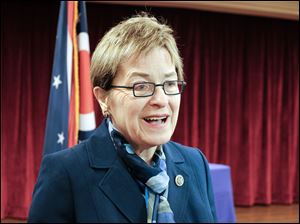
EDITORIAL
Kill the snake by the lake
1/16/2018
U.S. Rep. Marcy Kaptur
As the General Assembly moves to redraw Ohio’s congressional districts, the Republican-controlled legislature must make northwestern Ohio a top priority.
It should undo the damage that was done in 2011.
It should make sure that Toledo is not denied a congressman in future years.
In 2011, the General Assembly created a legislative map that is as good an example of gerrymandering — districts drawn to assure party advantage rather than good representation — as can be found anywhere in the country.
Click here to view more Blade editorials | Check out the Behind The Editorial series
Here in northwest Ohio, the 9th Congressional District, which centered on Toledo for more than a century, now shares territory with Cleveland. The district hugs the Lake Erie shore, from west Toledo through Port Clinton, Sandusky, Lorain, Lakewood, and other communities, ballooning out in Cleveland. It has earned the nickname “snake by the lake.”
Because of that map, U.S. Rep. Marcy Kaptur (D., Toledo) has to spend much of her time in greater Cleveland, focusing on Cleveland and Lorain issues.
Because of the snake by the lake, Miss Kaptur was forced into a primary fight in 2012 with her colleague, then-U.S. Rep. Dennis Kucinich of Cleveland. Two incumbent congressmen vied for one congressional seat, and one was going home at the end. Miss Kaptur retained the Democratic Party nomination that year, in part because her hold on the greater Toledo vote was so tight.
But more voters reside in the Cleveland end of the district, and therein lies the problem.
Miss Kaptur could keep on winning re-election in the 9th as long as she wants to stay in office. She’s already been in Congress since 1983 and is the longest-serving woman now in the House. She could serve another decade, at least. She is beloved in the Toledo end of the snake and respected in the Cleveland end.
But one day Miss Kaptur will go, and in a race between two Democrats in the 9th District, one from the west and one from the east, the candidate based in Cleveland would, based on the distribution of population, probably win.
State Sen. Matt Huffman (R., Lima) was the leader of the 2011 redistricting. That plan was wildly successful for Republicans. It squeezed as many Democrats as possible into four districts, enabling Republicans to win comfortably in the other 12.
Now we are approaching another redistricting — it happens following every 10-year census. And Ohio has lost population, so it could well lose another congressional district.
At present, Ohio’s congressional redistricting is controlled entirely by the General Assembly, which at present has a veto-proof GOP majority in both houses. Mr. Huffman has a new plan that allows for a modicum of input by the minority party, and there is a reason for that beneficence. There is a proposal from the League of Women Voters headed for the Nov. 6 ballot that would turn over the redistricting process to a bi-partisan commission.
Since the late 1800s, greater Toledo has been the anchor of a congressional district and has had its own congressman.
If the snake is left intact, this will likely not be so after Miss Kaptur retires. And that would be a travesty for this city and this region.
The General Assembly must kill the snake by the lake and ensure that Toledo is once again the core of its own congressional district.
If the legislature cannot do this, it is prima facie evidence that a bipartisan commission is needed.
Follow @BladeOpinion on Twitter.